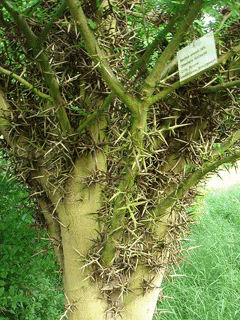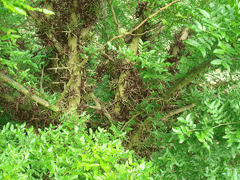 |
|
http://commons.wikimedia.org/wiki/User:Rupp.de |
 |
| http://commons.wikimedia.org/wiki/User:Rupp.de |
Translate this page:
Summary
Bloom Color: Yellow. Main Bloom Time: Early spring, Late spring, Mid spring. Form: Irregular or sprawling, Rounded.
Physical Characteristics

 Gleditsia sinensis is a deciduous Tree growing to 12 m (39ft 4in) at a medium rate.
Gleditsia sinensis is a deciduous Tree growing to 12 m (39ft 4in) at a medium rate.
See above for USDA hardiness. It is hardy to UK zone 5. The species is hermaphrodite (has both male and female organs) and is pollinated by Insects.
It can fix Nitrogen.
Suitable for: light (sandy), medium (loamy) and heavy (clay) soils and prefers well-drained soil. Suitable pH: mildly acid, neutral and basic (mildly alkaline) soils. It cannot grow in the shade. It prefers dry or moist soil and can tolerate drought. It can tolerate atmospheric pollution.
UK Hardiness Map
US Hardiness Map
Synonyms
Plant Habitats
Woodland Garden Canopy;
Edible Uses
Edible Parts: Leaves Seed
Edible Uses:
The seed is roasted, dehusked, soaked until soft then boiled and eaten with sugar[179]. Young leaves - cooked. A famine food used when all else fails[177].
References More on Edible Uses
Medicinal Uses
Plants For A Future can not take any responsibility for any adverse effects from the use of plants. Always seek advice from a professional before using a plant medicinally.
Anthelmintic Antibacterial Antifungal Antipruritic Antitussive Astringent Emetic Epilepsy
Expectorant Febrifuge Haemostatic Laxative Skin Stimulant VD
A decoction of the leaves is used for washing sores[218], including syphilitic skin diseases[174]. The stem bark is anthelmintic and febrifuge[218]. The fruit is antibacterial, antifungal, antitussive, astringent, emetic, expectorant, haemostatic and stimulant[174, 176, 178, 218]. It is used in the treatment of bronchial asthma with sticky phlegm, epilepsy and apoplexy with loss of consciousness[176]. Overdosage can cause poisoning of the entire body, haemolysis of the blood[176]. The seed is emetic, expectorant, decongestant and purgative[147, 218]. They have been used in the treatment of cancer of the rectum[218]. The root bark is anthelmintic and antifebrile[218]. The thorns on the plant are antipruritic[176]. They are used in the treatment of acute purulent inflammation, dermatopathies and tonsillitis[176]. They should not be used by pregnant women[176]. The plant has been used in the treatment of lockjaw, stroke, acute numbness of the throat and epilepsy, but the report does not make clear whether the seed or the thorns of the plant are used[147]
References More on Medicinal Uses
The Bookshop: Edible Plant Books
Our Latest books on Perennial Plants For Food Forests and Permaculture Gardens in paperback or digital formats.

Edible Tropical Plants
Food Forest Plants for Hotter Conditions: 250+ Plants For Tropical Food Forests & Permaculture Gardens.
More

Edible Temperate Plants
Plants for Your Food Forest: 500 Plants for Temperate Food Forests & Permaculture Gardens.
More

More Books
PFAF have eight books available in paperback and digital formats. Browse the shop for more information.
Shop Now
Other Uses
Soap Tannin Wood
The pod is used as a soap substitute[46, 61]. The seed is used[178]. Tannin is obtained from the seedpod[61]. Wood - strong, durable, coarse-grained[82]. Used for general construction[46, 61].
Special Uses
Nitrogen Fixer
References More on Other Uses
Cultivation details
Landscape Uses:Border, Rock garden, Specimen. Easily grown in a loamy soil, requiring a sunny position[11]. Succeeds in most soils[200]. Tolerates drought once established[1] and atmospheric pollution[200]. Rather tender when young, it grows best in S. Britain[11]. A tree at Cambridge Botanical Gardens was 13 metres tall in 1985[11]. Trees have a light canopy, they come into leaf late in the spring and drop their leaves in early autumn[200] making them an excellent top storey tree in a woodland garden. Plants in this genus are notably resistant to honey fungus[200]. This species has a symbiotic relationship with certain soil bacteria, these bacteria form nodules on the roots and fix atmospheric nitrogen. Some of this nitrogen is utilized by the growing plant but some can also be used by other plants growing nearby[200]. Special Features:Not North American native, Fragrant flowers, Inconspicuous flowers or blooms.
References Carbon Farming Information and Carbon Sequestration Information
Temperature Converter
Type a value in the Celsius field to convert the value to Fahrenheit:
Fahrenheit:
The PFAF Bookshop
Plants For A Future have a number of books available in paperback and digital form. Book titles include Edible Plants, Edible Perennials, Edible Trees,Edible Shrubs, Woodland Gardening, and Temperate Food Forest Plants. Our new book is Food Forest Plants For Hotter Conditions (Tropical and Sub-Tropical).
Shop Now
Plant Propagation
Seed - pre-soak for 24 hours in warm water and then sow in spring in a greenhouse[78]. The seed should have swollen up, in which case it can be sown, if it has not swollen then soak it for another 24 hours in warm water. If this does not work then file away some of the seed coat but be careful not to damage the embryo[78]. Further soaking should then cause the seed to swell. One it has swollen, the seed should germinate within 2 - 4 weeks at 20°c. As soon as they are large enough to handle, prick the seedlings out into individual deep pots and plant them out into their permanent positions in the summer. Give the plants some protection from the cold for their first few winters outdoors.
Other Names
If available other names are mentioned here
Native Range
TEMPERATE ASIA: China (Anhui Sheng (except w. & n.e.), Fujian Sheng, Gansu Sheng, Guangdong Sheng, Guangxi Zhuangzu Zizhiqu, Guizhou Sheng, Hebei Sheng, Henan Sheng, Hubei Sheng, Jiangxi Sheng, Jilin Sheng, Shaanxi Sheng, Sichuan Sheng, Yunnan Sheng, Zhejiang Sheng)
Weed Potential
Right plant wrong place. We are currently updating this section.
Please note that a plant may be invasive in one area but may not in your area so it's worth checking.
Conservation Status
IUCN Red List of Threatened Plants Status :

Growth: S = slow M = medium F = fast. Soil: L = light (sandy) M = medium H = heavy (clay). pH: A = acid N = neutral B = basic (alkaline). Shade: F = full shade S = semi-shade N = no shade. Moisture: D = dry M = Moist We = wet Wa = water.
Now available:
Food Forest Plants for Mediterranean Conditions
350+ Perennial Plants For Mediterranean and Drier Food Forests and Permaculture Gardens.
[Paperback and eBook]
This is the third in Plants For A Future's series of plant guides for food forests tailored to
specific climate zones. Following volumes on temperate and tropical ecosystems, this book focuses
on species suited to Mediterranean conditions—regions with hot, dry summers and cool, wet winters,
often facing the added challenge of climate change.
Read More
Expert comment
Author
Lam.
Botanical References
11109200
Links / References
For a list of references used on this page please go here
Readers comment
© 2010, Plants For A Future. Plants For A Future is a charitable company limited by guarantee, registered in England and Wales. Charity No. 1057719, Company No. 3204567.